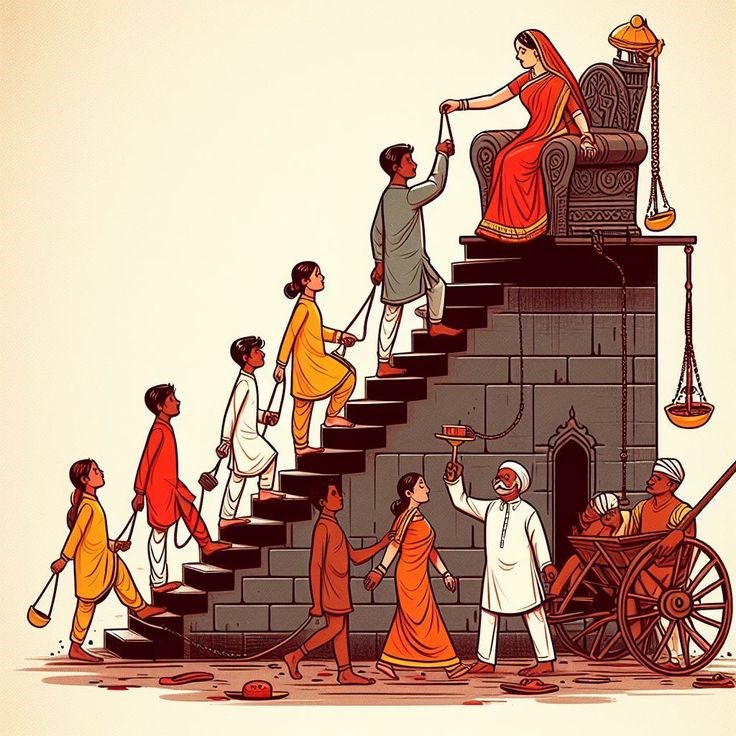Search here

11-Jun-2025 , Updated on 7/21/2025 6:58:49 AM
Why Are We Still Divided by Caste in a Modern Democracy?
Caste Persists Despite Legal Reforms
Even after the constitution protection and anti-discrimination legislation, the caste is still deep rooted in Indian society. The law has been changed, such as the Scheduled Castes and Tribes (Prevention of Atrocities) Act to guard the marginalized groups, but discrimination on the basis of caste is still observed in areas of education, hiring and firing, and social relations. The caste prejudices have not been eliminated by urbanization and modernization; they tend to be reflected in the matrimonial preferences, hierarchy at the workplace, and resource accessibility. Although the representation has been enhanced by affirmative action, equality is still hampered by systemic biases. The disparity between the law and the reality on the ground indicates the importance of having stronger enforcement of the law and social transformation. The illegal but still existing practices of caste-based violence and untouchability are only some of the proofs that legislation cannot destroy centuries-old hierarchies without the collective consciousness and responsibility.
Social Conditioning Fuels Caste Divisions
The differences in castes exist because of the strongly held social programming that makes the hierarchy and discrimination seem natural. Since childhood, people are subjected to the caste-based roles, which elevate or degrade a person based on birth. These divisions are reinforced by cultural practices, religious discourses, and family traditions, and they appear to be natural. These biases are frequently reinforced without being undermined by the media and education systems which find subtle ways of perpetuating them. Power, both economic and political, continues to be held by dominant castes and this marginalizes further the oppressed groups. This cycle has to be broken through conscious unlearning which involves encouraging inter-caste interactions, equal policies and representation. Devoid of tackling the real cause, which is social conditioning, the caste-based discrimination will persist further hampering the social cohesion and development. The transformation requires efforts to be made collectively so that biased traditions can be broken and a path towards equality can be paved.
Economic Inequality Reinforces Caste Hierarchies
Economic inequality is known to sustain the caste hierarchies because it affirms systematic disadvantage against the marginalized communities. Poor access to education, jobs and capital keeps the lower-caste groups in the cycles of poverty and the privileged castes have control over the resources and opportunities. These disparities are further reinforced by discriminatory hiring practices, wage disparities, and unequal land ownership. Affirmative action and government policies have borne some fruits, which have been, however, nullified by strong social biases which have been difficult to eliminate. The upper castes have been concentrated in wealth, which guarantees them political and economic power; thereby obstructing social mobility of the oppressed groups. In the absence of specific economic changes and the vigorous upholding of anti-discrimination legislation, caste-based inequality will remain entrenched and this will perpetuate an unfair hierarchy that is out of step with ideas of fairness and justice.
Political Exploitation Perpetuates Casteism
Politicians have deliberately exploited casteism, which makes it deep-rooted in the society. The political parties have often misused the caste identities to garner vote banks which have instead of solving the systemic inequities strengthened the divisions. They compare and imply stereotypes by focusing on electoral advantages instead of social justice as they maintain structures of hierarchy. Reversals during reservations and welfare schemes, however crucial they might be, have been tokenism, and have failed to end caste based oppression. Rather than trying to break the caste differences and working towards unity, the politicians enhance the disparities and make them instruments of mobilization. Such a cynical stance prevents the realization of a better, egalitarian society because caste still determines who gets the opportunities and the dignity. So long as political interests continue to rely on the tactics of division instead of actual reform, casteism will remain a weapon of power instead of being an artifact of bygone days.
Education Alone Can’t Eradicate Caste
The caste discrimination is entrenched within the social system and no amount of education will be able to uproot it. Education contributes to the spread of awareness and rationality, but the systematic biases are maintained by cultural expectation, financial inequalities, and institutionalization. Academic knowledge is frequently superseded by historical oppression and prejudices that have deep roots, thus resulting in further exclusion and inequality. Social reforms and legal measures should be used to supplement education in order to effectively oppose caste hierarchies. It is necessary to level the playing field through affirmative action, sensitization programs and tough implementation of anti-discrimination legislations. Education will be an incomplete solution without addressing the barrier of systems and attitude. Caste can only be really eliminated through collective movements, policy changes, and a paradigm change in the social mindset as well as academic empowerment.

Content Writer
Hi, I’m Meet Patel, a B.Com graduate and passionate content writer skilled in crafting engaging, impactful content for blogs, social media, and marketing.
Comments
Join Our Newsletter
Subscribe to our newsletter to receive emails about new views posts, releases and updates.
Copyright 2010 - 2025 MindStick Software Pvt. Ltd. All Rights Reserved Privacy Policy | Terms & Conditions | Cookie Policy